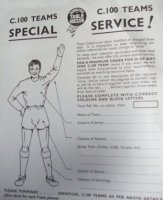
| Peter Upton's |
Subbuteo Tribute Website. |
|
The Team Colours Project. |
|
Classic Heavyweight 1967-1980. |
|
Non-catalogued Heavyweights (Named box sides). |
This page completes the heavyweight section of the team lists by looking at, and helping to identify any heavyweights not in the numbered range. There are an increasing number, and because of the ease of repainting h/w teams it is hard to tell the real from the fantasy.... Nevertheless, I hope to show some of the interesting teams within the collecting community. In truth, this is a bit of a minefield, as so many Subbuteo teams have been painted at home either by children at the time, or unscrupulous ebay sellers in the age of collecting. Nevertheless, there are some great looking teams in this selection, and it is up to the individual collector to decide whether they want to dip a toe into this area.
Why all these different named teams? Allow me to introduce the C100 Special Service!
The C100 Special Service.

As any heavyweight collector will tell you, the Subbuteo number range is not the whole story of production. Although the Subbuteo numbering system remained intact until 1996, SSG did release teams in named boxes from time to time. Most of these eventually made it into the standard numbering system, but a few did not.
The main source of these teams, was probably the C100 (and R100) Special Service provided to retailers. For a minimum order of just fifty teams, a retailer could request any club name and kit that he wanted. The delivery time was impressive - "approx three weeks from date of order". The leaflet (shown above) explains that "Team colours are often modified or changed these days. It is impossible to keep re-printing our colour references for every change in "strip". To keep your selection up-to-date and meet local demands, we now offer this unique special service". Most collectors assume that it is the "typed named boxes" of the early 1970s that were produced under this service. Perhaps the stamped boxes were part of this as well.
Whilst potentially exciting for modern collectors, care must be taken. Firstly, updating teams with the latest trim, or colours was something that kids in the 1970s were happy to do themselves. I have seen many corrections and adaptations along these lines. Sometimes the changes are small, and it isn't easy to tell when it was added. Examples of trim additions might be white collars and cuffs on Uruguay, or yellow on Crystal Palace. Of course as Subbuteo was hand-painted using basic humbrol colours, the 1970s re-painters were often using the same paint. How to tell?
Even more problematic is the "modern" re-painting of kits - usually for profit by unscrupulous collectors and dealers. This has happened for as long as Subbuteo has been collected (i.e. at least since the early 1990s). The difference in price between a common team and a rare one has become so great, that so called "unique" teams must sadly be approached with some level of suspicion. And as these re-painted teams get older, and pass through the hands of more collectors, the problem is only going to get worse.
July 2020: Previously in assembling my list of "named" teams, I did not included every possible rarity that has been sighted. I had a folder on my PC for teams needing more details. I have decided to show many of these to perhaps start a debate or two, and not keep anything hidden. Collectors are not infallible though, and each side here must be considered on its own merits.
At this point I need to point visitors in the direction of the "Celtic Dream" heavyweight catalogue's rarities page. This has good pictures of a number of named box teams. Rather scarily, these teams have only a slight overlap with mine, and there are far more foreign sides. This suggests the tip of an iceberg! I mention some of these teams on my lists, but have not generally illustrated them. Both pages need to be considered if you are trying to put together a list.....
December 2020: A big thank you to heavyweight
expert Mark Skellon, who has supplied details of another 20+ named boxes. As so
many of these teams do exist within the normal numbered range (even the typed
box teams), I have re-jigged the page a little.
Labels and Dating.
Subbuteo have released named teams with several styles of label. These
do overlap somewhat in date, suggesting
different factories or maybe unsold stock. However, as I've checked the teams to
the wonderful Historical kits website, I have found some distinct ages that
match box types and differing labels. There are a few teams that seem to be released under
different versions (Derby County are the prime example), although most outfits
worn long-term do find their way to the
proper number
range.
The earliest label appears to be the printed plastic strips used
for the 1966-70 World Cups, which saw very limited use for club sides. Then
there were the simple "typewriter" style of labels, which look like a step
backwards. These seem to be the teams related to the "shop request" Special Service
mentioned above. Finally, there are stamped boxes, where the name is printed on
the box using an ink stamp. It has been suggested that shops may have stamped
boxes to aid identification and sales. It should be noted though, that the
Italian stamped teams are often mis-spelt (their rugby teams are a good
example). This suggests stamping in the UK rather than Italy, which of course
suggests factory stamping. Again, these teams seem to be localised
shop requests on the whole. A number of foreign ranges seem to have been in
stamped boxes, including the aforementioned Italian range, and lower down the
page you will find Halmstad (Sweden) and Beira Mar (Portugal). It is likely that
in countries where the whole Subbuteo range was not issued, it
made sense to sell the teams named, rather than numbered. Finally, in the short-box era there are small printed labels,
and some that look a bit like the typed ones of old. There is a possibility of stamped teams too. In exported Subbuteo, it has been noticed that German teams
in the standard reference range often have typed sticky labels.
Typed Name Boxes 1970-71 (and beyond).
Collectors generally see these teams as the result of
the C100 Special Service, where individual sports shops
could request a small run of unique sides.
The early 1970s is certainly a strange era for Subbuteo teams, as
the normal team range begins to expand. It is odd
that some minor sides make the team range, and others
only appear here. Issuing short runs of teams in named boxes
may have been a logical response to increased "unique kit"
experiments, that often left teams in the numbered range
"out-of-date" before they had even arrived. This might
even have been triggered by the 1970 range additions. Among
these, Montrose stopped wearing ref 63 that year,
Clydebank (73) had actually stopped wearing red shirts
in 1969, and Forfar's hoops (75) seem to date from 1968.
That said, named boxes were not used as a long-term
solution. 1971 saw a few away kits added to the number
range, and 1972 saw Manchester United, Birmingham City
and Crystal Palace arrive (refs 100-102 - and see below!).
Pleasingly, a reasonable number of quirky and
interesting teams exist within this series. The name
strips are cheap and nasty to be honest, simply typed
up, hand-cut and glued on. Even what is written on them
can vary (the words "strip" or "new" sometimes appear). For me, it's the most exciting bit of
heavyweight collecting, because I don't think it has all
been catalogued yet, and there is always a chance of new
teams coming out of the woodwork.
Derby County seem to be the most common of these teams,
and the only one whose sale might have been more
widespread. I have also seen stamped boxes for this
team, although still in this early box (see below). That is the
usual Subbuteo "spanner" when it comes to dating
non-catalogued stuff!
July 2020: I have split the list into teams in the
earlier boxes with "OO scale players" written on the end, and the
mid-1970s boxes with
"OO scale Team" on the end (some hw collectors
call these Splash box due to the larger logo). Thanks to the
research on real kits done by the
Historical
Kits website, we can date these outfits accurately.
Both
lists have very tight dating periods that match what we
know of the box dates perfectly.
An interesting oddity with regard to these teams is shorts trim. As a rule,
shorts trim does not appear on teams in the numbered range until the late 1970s
(Middlesboro at 171 are probably the first). However, the early version of
reference 53 Portsmouth with shorts trim is well documented, and the named box Derby,
Mansfield
and Northampton Town also have this trim. Possible kits seen without a named box..... Not everything in Subbuteo is black and white. Stockport are
an unproven kit, and shown in more details on the team odds and
ends page. However, they do have a nice story attached to them. It could be
wishful thinking, but it is the kind of teams you hope are real....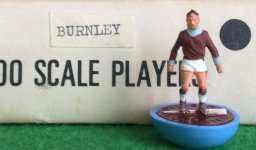
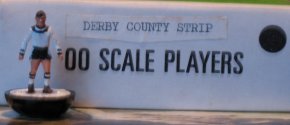

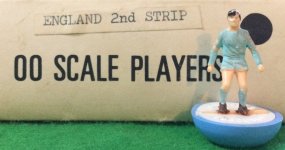
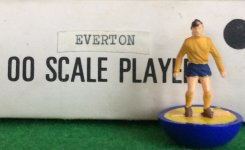
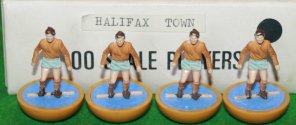
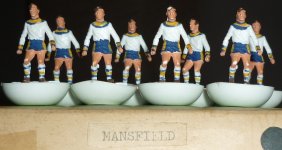

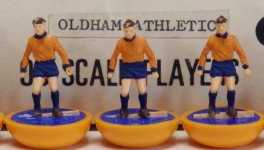

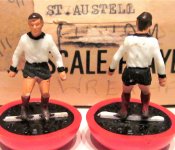

Typed boxes for teams that appear in the standard range in this era (OO scale players box).
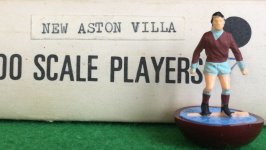
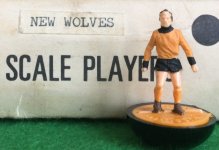
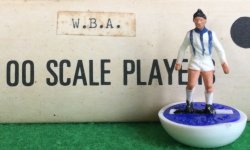
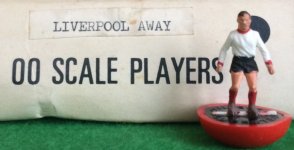
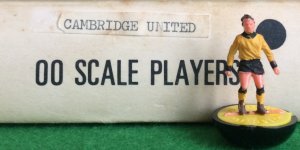
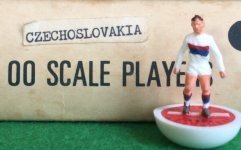
These team colours were worn in the same period as the kits above, and the only difference is that they do make it into the proper numbered range very quickly. The Aston Villa arrives among the team refs 62-75 as a "Stop Press!" on the World Cup 1970 fixture list "Available at your local stockist in May" (1970). Note that this is the early version of reference 74. In real life this kit proved unpopular with Aston Villa fans, and was only worn in 1969-70. Meanwhile, the "World Cup" style label (shown below) has only been seen with the later version of this Aston Villa. However, the "New Wolves" and the West Bromwich Albion are identical whichever label is used. The Wolves kit was first worn in 1969-70, and arrives in another "Stop Press" section, this time in the 1971-72 catalogue alongside the Liverpool 2nd kit which is also represented here. The West Bromwich kit is more difficult to date, because it becomes reference 3. There are more details on this side below.
Cambridge United is a puzzle, because it is just reference 6. Unless reference six was still gold at the point of release? When Cambridge United were elected to the fourth division at the expense of Bradford (PA) in 1970 they chose to wear an all-white strip (with their gold and black used as trim), and Subbuteo added them to their 1971-72 catalogue as reference 21. This means that this kit is either from their non-league days (worn 1967-69) or from when they returned to it in 1972-73. This later date would have probably been in the "splash" box though. So possibly a celebration of their election to the league, before the new kit was announced?
Note that the Aston Villa has reversed socks to the usual reference 74
Czechoslovakia is another weird team to find with a typed name. Surely it should just have a world cup sticker?
Plastic Strip/Printed Name boxes - 1969-70
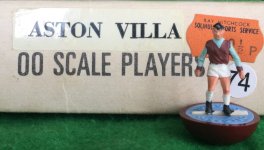


These name strips are identical to the 1970 World Cup team labels, and date to the same era. These labels seem to have a Birmingham/Midlands flavour, as the three teams I have seen in them are "New Wolves" and West Bromwich Albion and Aston Villa. (see above).
The New Wolves is identical to reference 77. Wolves swapped out of their all old gold kit (ref 49) for the 1969-70 season, and the kit does not arrive as ref 77 until the 1971-72 catalogue (in a Stop Press section). This suggests that the New Wolves boxes may exist between these dates. The Aston Villa is the second version of reference 74, which was first worn by Aston Villa in the 1970-71 season, and arrives in the Subbuteo catalogue in 1971-72.
West Brom is also interesting. It is the standard late reference 3, with black hair and boots, white socks, and no sleeve trim. It should be noted that the short-sleeved ohw ref 3 had brown hair and boots, sleeve stripes, and a blue ring on the socks, and this covered both Huddersfield and West Bromwich (among others). This earlier outfit has been seen on 1960s classic h/w ref 3s, so probably carried across. However, Huddersfield Town swapped to an all-blue shirt in 1966, leaving ref 3 as essentially a West Bromwich kit. West Brom. had gone to all-white sleeves circa 1964, and had all white socks from 1968-69. They also won the FA Cup in 1968, and it is possible that this box ties to this (although an away kit was worn in the final). It is dangerous to assume anything with Subbuteo, but it is possible that reference 3 was altered to match the named box side, when it was realised that no other big clubs were using it (as happened with the New Norwich City and reference 28 later in the 1970s). As with most Subbuteo puzzles, there are no records, so it is simply speculation.
The Aston Villa box here has a decimal price label from Solihull Sports Service.
Stamped Boxes in the Early 1970s period.
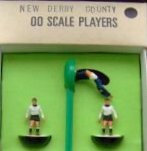
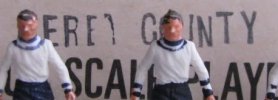
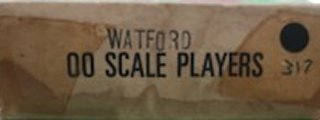
These pictures show that the stamped boxes and the typed ones run concurrently. Shown here are two Derby County boxes - one has the usual "special" version (albeit without the sock trim). The other contains what looks like a 1966 World Cup West Germany. A third tantalising box is shown with "Watford" stamped on it. This was owned by Chris Allen, but is, alas, empty. Watford were reference six in the Subbuteo catalogues of the period, but they actually wore a yellow/black/yellow kit with no trim at all (like a reference 284 which was produced later). So did this box house a reference 6 or something different?
I previously illustrated a Bologna with blue shorts here, but it has been pointed out by Italian collector Alberto Orazi, that this comes from a range catalogued by Edilio Parodi - so it is now on the Heavys 300+ page. (and we'll look at international stamped boxes later).
References 100-102 The "new" top flight kits 1972-73.
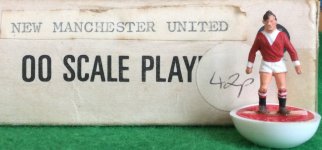
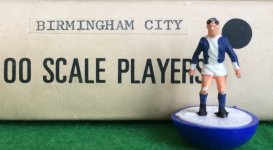
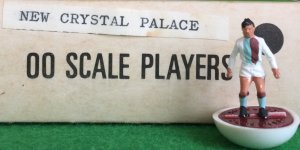
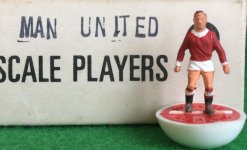
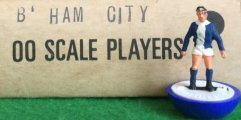
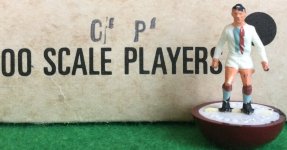
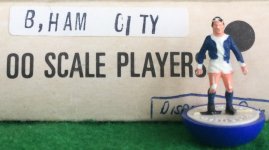
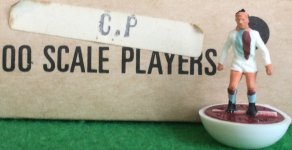
For me, this is the most surprising bit of "named box" detail supplied by Mark Skellon. These three kits arrive in the 1972-73 catalogue (in the middle of the expansion of Italian teams, rather oddly). All three teams were in the top flight in 1972-73, and all three are pretty common. I've seen plenty of all of them, and yet I have never come across a named box of any of them, and nobody has sent one in to the site before. Were they hiding in plain sight? Mark has rather heroically checked a lot of teams on ebay to put this collection together. Collectors generally feel that the 1972-73 range (stopping at ref 106) is the last year for the "OO Scale Players" boxes, and that teams with higher numbers than that should be in "Splash" boxes (see below). All these teams are the early box. In real life, the historical kits website suggests that all three of these kits were actually introduced in the previous season to the Subbuteo catalogue - i.e. 1971-72. So perhaps some (or all) of these boxes date from that year.
Three different styles are shown. The standard typed box, the standard stamped box, and then stamps on stickers, which we have yet to see anywhere else. Anyone have any more of these?
As usual, there are variations to how the teams are spelt out on all these name types.
The 42p price on the Man Utd does not match to Subbuteo team pricing sadly.
Later Typed Name teams 1972-74
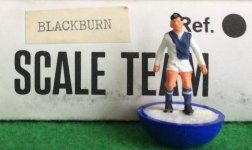
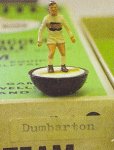
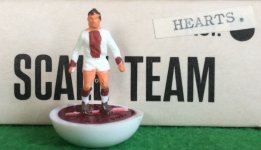
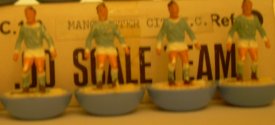

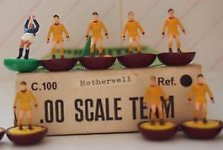


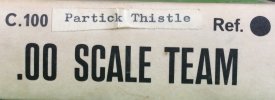
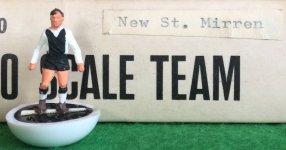
The list of typed name labels seen in the later "splash" style of box (with OO scale team on the end panels) as of July 2020 is as follows :-
Do you notice the pattern with these teams too? Many were worn in 1973, which was probably the first year of this new style of box. So the two lists are probably just one range carrying on into the new type of box.
Typed boxes for teams that appear in the standard range in this era (OO scale team box).
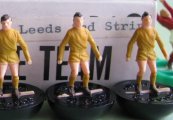
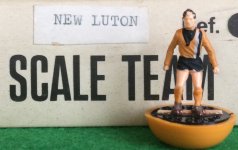
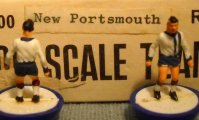
After the 100-102 teams in 1972-73, the next catalogue to have new UK teams is 1974-75, which sees 167 Rochdale to 173 Portsmouth illustrated, with teams to 190 on the list inside. Interestingly, four of the early numbered sides have now been seen as named boxes, albeit with some small differences....
Leeds United 2nd - This is the equivalent of reference 168, and is an earlier Leeds away kit than the Admiral trimmed version found at reference 208. Probably predates reference 168 which arrived in 1974-75 as Oxford United and Bradford City. Nice all black bases here.
New Luton - This one becomes reference 169. There are several variations of this Luton Town kit (none of which have the proper blue colour!) A second version of this named team on Alan Crampton's site (Subbuteo Passion) is identical to this one. This named version is a tangerine kit with a deep V collar, and the white stripe on the left. In the 1975-76 catalogue, the team is described as orange, but is more of an amber, with a round collar and black stripe on the left. A later version returns to the tangerine and the collar, but has a white stripe between two black. In real life, the stripe pattern does change - two stripes 1973-74, white stripe with blue edges 1974-79.
Burnley - As we have 168 and 169 illustrated, it is worth pointing out that ref 170 was seen as a named Burnley arrived in an earlier box (with extra sock trim).
New Portsmouth - This kit becomes reference 173 in the 1974-75 catalogue, although note that this version has a red hoop on the socks. When moved to 173 the kit changed to white shorts in the illustration (but not the description). In real life, it was officially always worn with blue shorts 1973-76.
Thanks to Jamie Ballard, James Sheldon, Jon Rosten, Nick Samson, Mark Skellon Chris Allen and Alberto Orazi for their help with these early lists.
Stamped Named Boxes 1976 and beyond....
This era already has some confusing issues.
The English catalogues seem straightforward, with the range staying at 190 for three catalogues - 1974/75, 1975/76, and 1977, but new team production did not stop. The 1975/76 Italian catalogue added teams for references 191-195, but these were not the same as those eventually added to the 1978 English version. In addition, in 1976 the Italians produced teams in a 501-528 range. These sides are found on the Italian Production page, and most eventually found their way into the 1978 catalogue expansion. In the midst of all this numbering chaos, the box type changed once more as the mid-1970s long box gave way to a smaller model with a plastic insert.The teams working their way through this number confusion are usually known as the "new" teams, on account of them being modern versions of sides that were already in the range, and due to the word "New" that often appears on the boxes. With the numbers not yet set in stone, many were sold named in stamped boxes. It is worth noting that the abortive 191-195 range also tended to have the numbers stamped on the boxes.
The "NEW" teams 1976-77


Outside of the World Cups, these are the most common named box sides you will find. The named teams are usually in the long box, but this is not always the case. Most of the teams go on to appear in the number range firstly as the aborted 191-195 (in long boxes), and later between 205 and 211 (in short boxes). However Norwich finds its way back to 28, Burnley replaces the existing team at 170, and Southampton doesn't make it to the standard list at all. Note that these are all in the later long boxes with "OO Scale Team" on the end, rather than "OO scale players".
International Sides.

An updated England kit with red and blue trim was introduced as C138 in 1977, and this seems to have prevented a named box team (at least, I've never seen one). In 1978 this kit was joined by the rest of the home nations in the C500 range, but the named boxes pre-dated this. Northern Ireland changed to green shorts whilst being a C500 team, so a named box version seems less likely.

July 2020:- In the course of the revamp of this page, I've checked out other h/w sources online, and found that the teams from this list do not include the word "new" as often as I'd assumed. In fact, they do not look any different to the rarer named box teams in the list below, many of whom don't make the team range. At the very least, it suggests that the New Southampton should be in the second list, although it seems a more widespread release. See Catalogo – Subbuteoblog for more and bigger h/w box pictures from around the community.
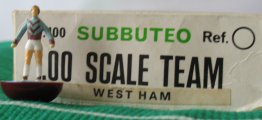
These named teams also run into the smaller boxes that house the 1978 expansion. Although many of these are now in their numbered form, named boxes continue, but the naming method changes. In a throw-back, the teams in the small boxes return to typed (or printed) name stickers. The West Ham I own in this format is a zombie with a printed sticker (see above). However, typed versions exist.
More unusual "new" teams....
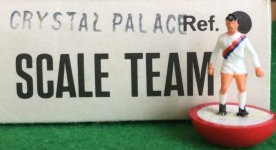
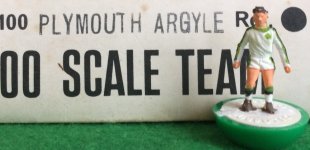
Here are two more sides from the 191-211 range, which perhaps should be regarded as part of the "new" teams production. However, the old list has existed in collecting circles since the 1990s, and I'm loath to add to it! In addition, neither of these teams were in the abortive 191-195 range. If we find a box or two with "new" on them, then I might have to bump them up....
Stamped box oddities.




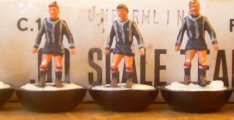
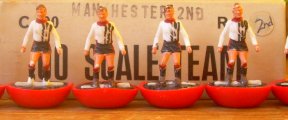
As at July 2020 the list stands as follows:-
There is a possibility that the Manchester City 2nd on 324 was also a named box heavyweight. I've heard of it existing (although not seen convincing pictures), and the dates are similar to the Manchester United version (i.e. Manchester City seem to have stopped wearing it by the time it arrived on the lists in 1980).
Short Box Teams 1976-78?
Personally, I had not seen unusual named teams in this era. There are the "new" teams shown above, and the German sides at reference 210-223 do seem to favour named boxes for the German market. However, Celtic Dream's heavyweight list has both a stamped box, and a typed one for this era. Both are British sides, and both are very much based on existing teams.
Melchester Rovers.

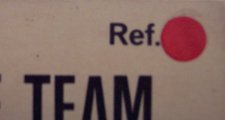
Melchester Rovers are, of course, the team Roy Race plays for in legendary comic strip Roy of the Rovers. I can remember this team being advertised for sale in the comic around 1979-80, and I'm sure it had a heavyweight player on the advert. A long box version would likely come from the mid 1970s, and I suppose it could have had a shop request. Of course, it could well be a repaint (painted onto a ref 41, it would be difficult to tell). It is a strange one, as various site visitors have been sure they saw or owned this team at the time, and yet they don't turn up in collecting circles. The lightweight versions are not that uncommon, so you'd think we'd see more of this team if it had been made available.
July 2020: The Celtic Dream h/w list has a black haired/booted h/w Melchester Rovers.
This final section is for international heavyweight club sides. It is known that the French had there own factory, and produced a different range of teams. There was a Spanish factory in the 1960s. The Italians produced their own figure in the late 1970s. These international releases have their own detailed pages, which are listed below, but I've added a few details and pictures here so that this page become more of a tick list.
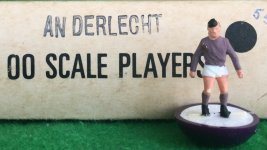
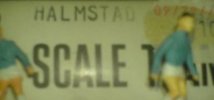
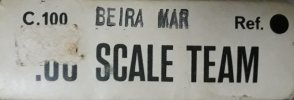
A few stamped boxes exist in collecting circles. These three illustrated sides are all in the normal range.
Anderlecht (Belgium) - reference 55.
Halmstad (Sweden) - Like many of the named long-box teams, Halmstad makes its way into the number range in the big 1978 update. Not sure from this photograph whether this team is the mid-blue of the ref 292 Halmstad, or whether it is just a reference 5! The price label is not a British one.
Beira Mar (Portugal)- Portuguese collectors have advised that heavyweights in Portugal were always sold in named boxes such as this one (Beira Mar were reference 6 in the UK). As these are in the standard range, I've added them to Heavys 300+ others
France
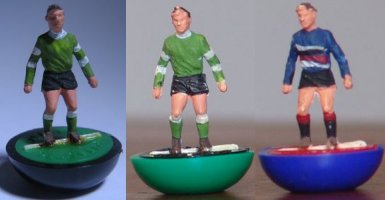
The French did paint their own variations, to keep their catalogues accurate. However, most of these variations do feed back into the standard lists. Delacoste Teams gives the required catalogue details. It is worth looking at the Team odds and ends page for the above pair of teams. Often featured in Italian collections, the odds and ends page has a good argument for them being a pair of French away kits.
Holland
The Dutch teams arrived in the UK catalogues en-masse in
1972-73. The unique kits for that year's top flight became references 82-89, and
the rest of the teams fitted into the standard range, along with a number of the
bigger lower league sides. The aforementioned Celtic Dream site has two early
1970s boxes with typed Dutch team names on them. These are PSV, and Sparta, both
of whom are on reference 9 in the UK catalogues. The Sparta Rotterdam with a
blue shirt, with their usual red and white colours as a diagonal, so it looks like it might be
an away kit.
There are also anomalies in the 1970s Dutch catalogues when compared to the
standard 82-89 range, but I've yet to see pictures for any of these.
Italy.

The Italians certainly produced their own teams (and their own figure - the Hybrid), but most of their variations were featured in Parodi's catalogues (how else would he sell them?). The 501-509 range was often sold with typed name labels (however, these all seem to be hybrids). However, there are a couple of stamped Italian boxes that need to be considered.
Spain
They seem to miss out on team production in the 1970s catalogues, but the un-catalogued 1960s production in ohw and rugby figures are worth a look - Spanish teams
That does seem to reach the end of the heavyweights. Move on to zombies, or lightweights.... or something else entirely.
[ Main Page | Previous Page | Next Page ]